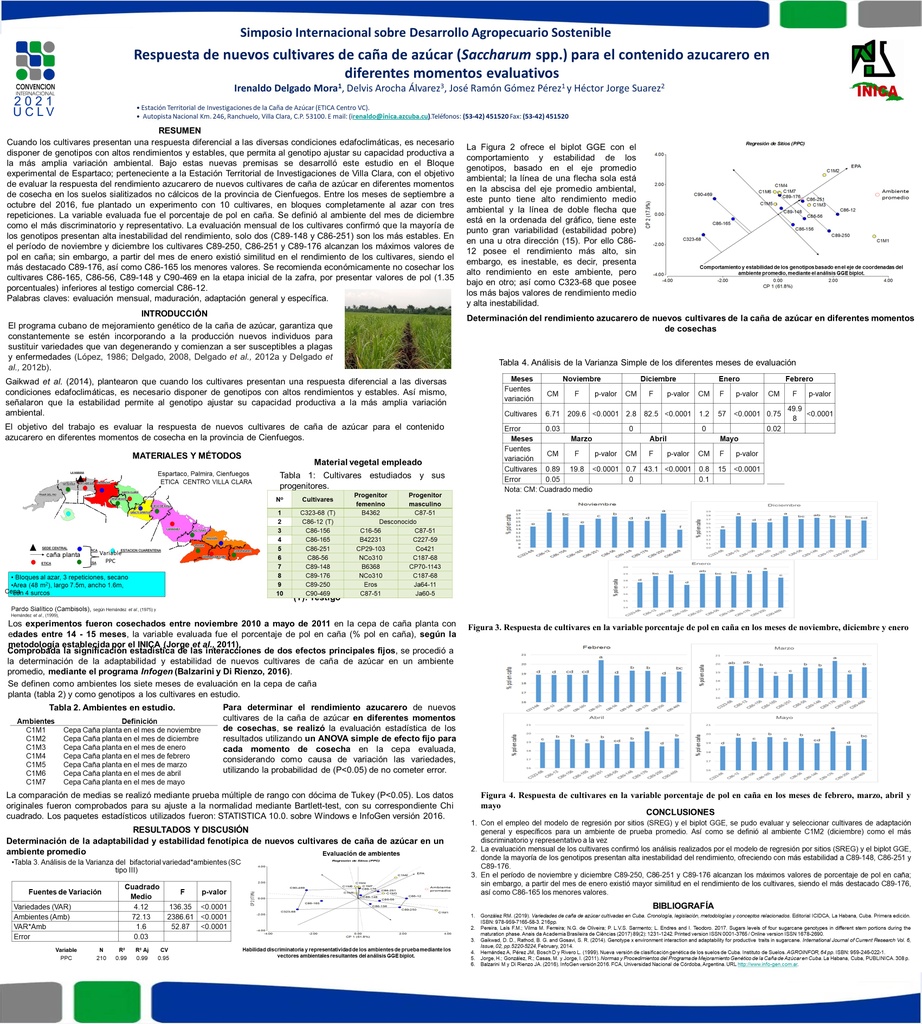Executive Secretary

X Conferencia Científica Internacional sobre Desarrollo Agropecuario y SostenibilidadAGROCENTRO 2023
Agrocentro 2021

Resumen
Cuando los cultivares presentan una respuesta diferencial a las diversas condiciones edafoclimáticas, es necesario disponer de genotipos con altos rendimientos y estables, que permita al genotipo ajustar su capacidad productiva a la más amplia variación ambiental. Bajo estas nuevas premisas se desarrolló este estudio en el Bloque experimental de Espartaco; perteneciente a la Estación Territorial de Investigaciones de Villa Clara, con el objetivo de evaluar la respuesta del rendimiento azucarero de nuevos cultivares de caña de azúcar en diferentes momentos de cosecha en los suelos sialitizados no cálcicos de la provincia de Cienfuegos. Entre los meses de septiembre a octubre del 2016, fue plantado un experimento con 10 cultivares, en bloques completamente al azar con tres repeticiones. La variable evaluada fue el porcentaje de pol en caña. Se definió al ambiente del mes de diciembre como el más discriminatorio y representativo. La evaluación mensual de los cultivares confirmó que la mayoría de los genotipos presentan alta inestabilidad del rendimiento, solo dos (C89-148 y C86-251) son los más estables. En el período de noviembre y diciembre los cultivares C89-250, C86-251 y C89-176 alcanzan los máximos valores de pol en caña; sin embargo, a partir del mes de enero existió similitud en el rendimiento de los cultivares, siendo el más destacado C89-176, así como C86-165 los menores valores. Se recomienda económicamente no cosechar los cultivares C86-165, C86-56, C89-148 y C90-469 en la etapa inicial de la zafra, por presentar valores de pol (1.35 porcentuales) inferiores al testigo comercial C86-12.
Abstract
When cultivars present a differential response to various edaphoclimatic conditions, it is necessary to have genotypes with high and stable yields, which allow the genotype to adjust its productive capacity to the widest environmental variation. Under these new premises, this study was developed in the Espartaco Experimental Block; belonging to the Territorial Research Station of Villa Clara, with the objective of evaluating the response of the sugar yield of new sugarcane cultivars at different harvest times in non-calcium sialitized soils of the province of Cienfuegos. Between the months of September to October 2016, an experiment was planted with 10 cultivars, in completely randomized blocks with three repetitions. The variable evaluated was the percentage of pol in sugarcane. It was obtained as the environment December was defined as the most discriminatory and representative. The monthly evaluation of the cultivars confirmed that most of the genotypes present high yield instability, only two (C89-148 and C86-251) are the most stable. In the period of November and December the cultivars C89-250, C86-251 and C89-176 reach the maximum values of pol; However, as of January, there was similarity in the yield of the cultivars, the most prominent being C89-176, as well as C86-165 the lowest values. It is economically recommended not to harvest cultivars C86-165, C86-56, C89-148 and C90-469 in the initial stage of the harvest, as they present much lower pol values (1.35) than the commercial control C86-12.
Sobre el ponente

MsC. Irenaldo Delgado Mora


